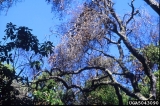
Photo by: Joseph OBrien, USDA Forest Service, Bugwood.org
In 1995, native oak trees in Marin County began dying in unprecedented numbers. It wasn't until 2000 that researchers at U.C. identified the cause to be a previously unknown fungus-like pathogen: Phytophthora ramorum.
The name "Sudden Oak Death" or "SOD" for short became the moniker for this organism due to the apparent sudden collapse of three major tree species: tanoaks, coast live oaks, and black oaks. SOD has now been found in over forty other plant species and includes forbs, shrubs and trees in wildlands and nursery settings. California bay laurel (Umbellularia californica), Camellia and Viburnum species are the three species of woody plants that seem to be the most susceptible to the SOD pathogen; but, western maidenhair fern (Adiantum aleuticum), wood rose (Rosa gymnocarpa) and false Solomon's seal (Maianthemum racemosum) have also been confirmed to be hosts of Phytophthora ramorum.
In order to contain the spread of the disease, the State imposed regulations controlling plant movement in 2001, with the federal government establishing an interim rule placing restrictions on the interstate movement of regulated and restricted articles in 2002. By 2003, the disease had been detected in 13 coastal or near coastal counties in California as well as in Oregon, Washington and British Columbia nurseries. In 2004, the federal government issued a Federal Order restricting the movement of nursery stock in California, Oregon and Washington.
The San Mateo County Agricultural Commissioner is the local enforcement agent for state and federal regulations concerning Phytophthora ramorum. The California Department of Food and Agriculture contracts with San Mateo County through the Agricultural Commissioner to ensure the inspection and certification of nurseries and nursery stock. This allows for the intrastate, interstate and international shipment of regulated products out of the quarantined area. Christmas trees are also inspected annually and shippers of wood products, wreaths, garlands, greenery, and green waste transporters are monitored for compliance with regulations on a quarterly basis.
SOD is currently found along Skyline Boulevard and in a portion of the San Francisco Watershed near Crystal Springs reservoir, and in the hills of Burlingame, Hillsborough, Redwood City, and Millbrae. Other locations with limited infestation include Water Dog Lake Park in Belmont, west of interstate 280 in Woodside and Portola Valley, and Atherton.
If you believe you have Sudden Oak Death, contact us by telephone at (650)363-4700 or by email at smateoag@smcgov.org
Review a current list of plants associated with SOD ( Phytophthora ramorum ).
For current information about Sudden Oak Death, visit the California Oak Mortality Task Force website.